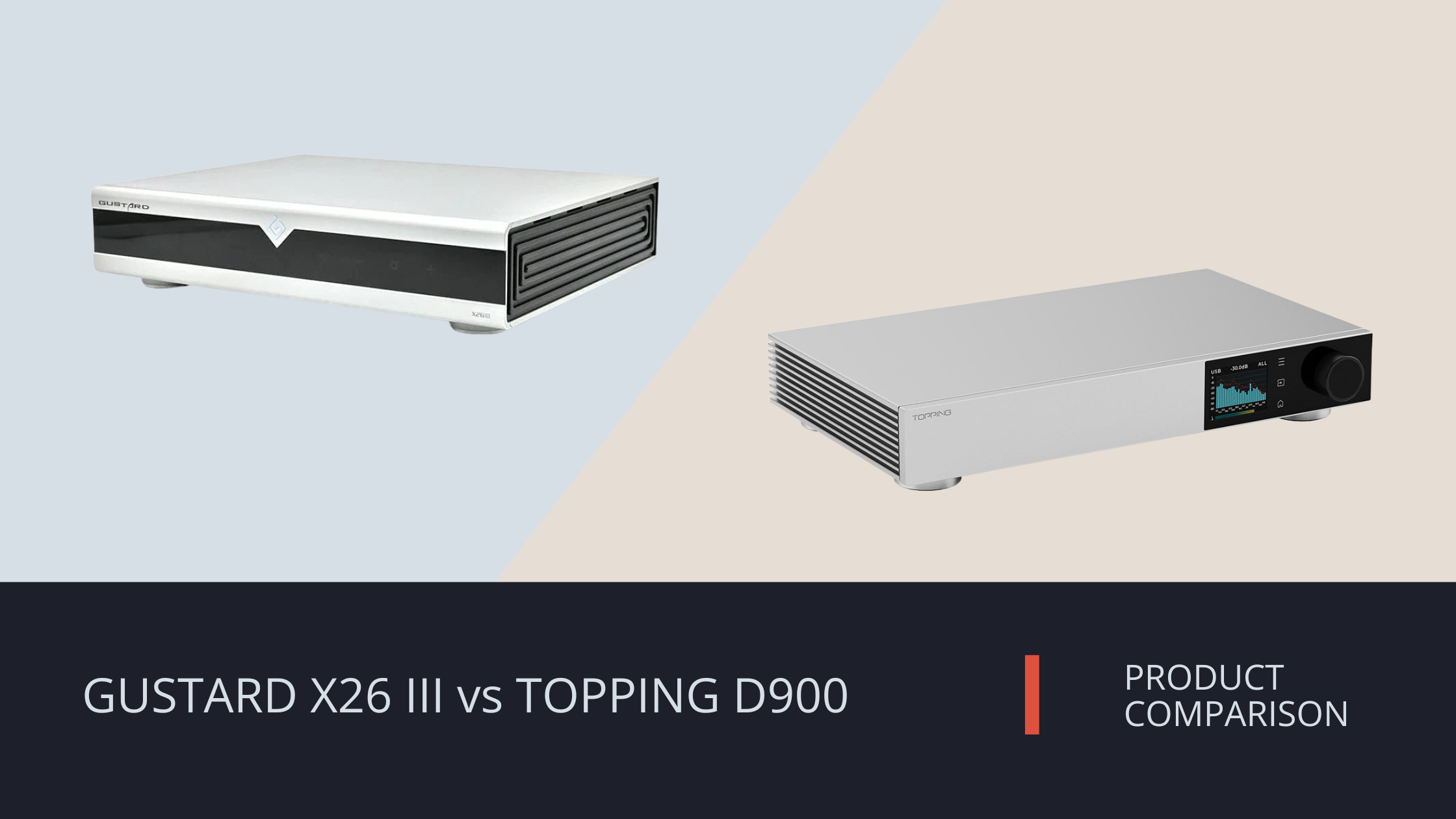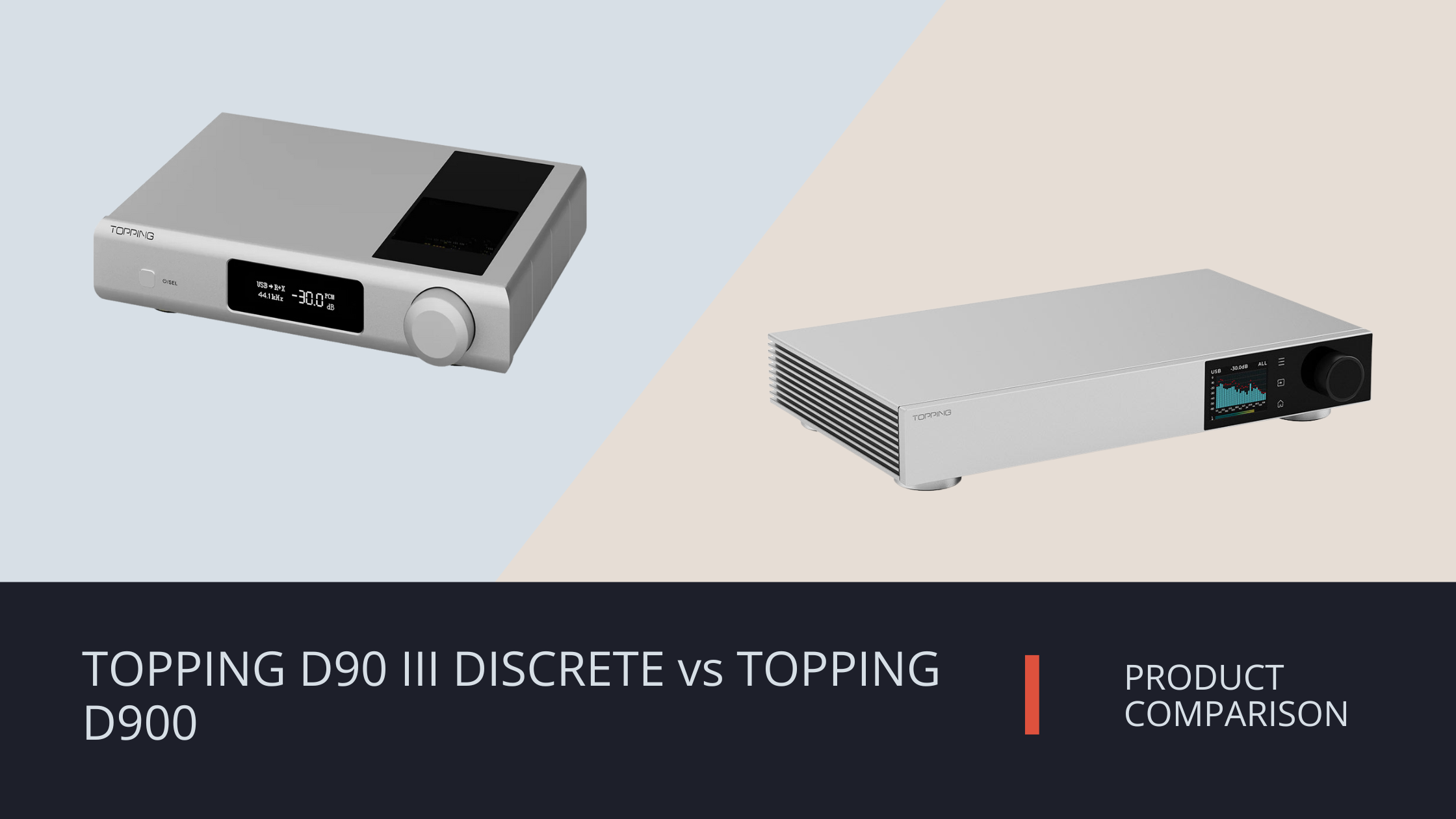
Gustard X26 III vs TOPPING D900
In this post, we’ll walk through how the Gustard X26 III and the TOPPING D900 differ in design, feature set, and use cases — and where each might fit best in a serious system. If you already know what balanced outputs and discrete architectures are, this will help you see where the trade-offs lie.
Overview
The Gustard X26 III is a high-end streamer/DAC that targets users who want built-in network connectivity, flexible digital inputs, and a strong DAC backbone. Its emphasis lies in delivering a full-featured front end plus high-end conversion.
The TOPPING D900 is a flagship DAC that focuses more on the conversion engine itself, in part integrating a volume (preamp) stage and trimming unnecessary analog stages. It’s for users who want top-tier conversion with flexibility but perhaps prefer to pair with external network front ends.
In rough terms: the X26 III leans toward “all-in-one streamer + DAC,” the D900 toward “ultimate DAC with preamp features.”
Architecture & Conversion Approach
Gustard X26 III: Dual ES9039SPRO, network bridge, FPGA filtering
- The X26 III uses two ESS ES9039SPRO chips, one per channel, in differential mode.
- It has a network bridge/streaming section with LAN support, Roon, AirPlay, UPnP, etc.
- There’s an FPGA + DSP section for digital filter and clock management, decoupling the digital domain from the conversion domain.
- The output stage is fixed volume (or variable, depending on mode), and the output impedance is about 100 Ω on both RCA and XLR.
Because of the fixed or variable output mode and moderate output impedance, you need to consider what your downstream gear expects (e.g., preamp or amplifier).
TOPPING D900: Fully discrete PSRM, integrated preamp mode
- The D900 uses a fully discrete 1-bit PSRM (Precision Stream Reconstruction Matrix) architecture, with 32-element discrete modules per channel.
- It has a custom I/V stage (i.e., the conversion out of the 1-bit module) built in-house, not relying solely on off-the-shelf op amps.
- It supports a preamp/volume mode with memory and can be used directly into a power amp or active speakers.
- The D900 only provides balanced XLR outputs, no RCA.
- In tests, the D900 achieves extremely low THD+N (< 0.000055 %) and high SNR / DNR (131 dB) in line/preamp configuration.
Because the D900 omits unbalanced outputs, you either need balanced downstream gear or reliable XLR-to-RCA conversion (with minimal impact).
Features & Connectivity Comparison
Here’s a breakdown of what each offers and how it may affect your system decisions.
| Feature | Gustard X26 III | TOPPING D900 |
|---|---|---|
| Streaming / Network | Integrated LAN bridge (Roon, UPnP, etc.) | No built-in network streamer (focus is conversion) |
| Digital Inputs | LAN, USB, I2S, coax, optical, AES, etc. | USB-B, USB-C, I2S (LVDS), AES/EBU, coax, optical |
| Bluetooth | None (or not emphasized) | Bluetooth 5.1 with LDAC / aptX support |
| Preamp / Volume Mode | Yes (variable output / fixed output switch) | Yes, with memory / as a direct preamp output |
| Outputs | RCA + XLR, with 100 Ω output impedance | Only XLR balanced outputs with 100Ω output impedance |
| Power Supply / Internal Design | Dual internal transformers, moderate power draw (<25 W) | Uses isolated supplies, switching modules, multi-rail regulators |
Performance Comparisons & Trade-offs
Noise, distortion, and dynamic capability
- The D900 posts extremely low THD+N and very high SNR / DNR in measurements and reviews (≈ 131 dB).
- The X26 III is rated for >128 dB dynamic range and SNR >127 dB.
- Because the D900 is discrete and optimized for the DAC + I/V + output chain, it may achieve cleaner measurements in more configurations (less dependence on modular components).
However, measurements are one thing — how these translate into sound will depend on the rest of the chain (especially power supply, cabling, amplifier).
Interfacing & system integration
-
The X26 III’s ~100 Ω output impedance means that downstream input impedance needs to be sufficiently high, or the load must be fairly stable, to avoid interaction.
- The D900’s output stage carries a similar ~100 Ω impedance on its balanced XLR outs, so the same consideration applies—it simply assumes a fully balanced signal path. Systems using adapters or unbalanced gear should account for this when pairing.
- The X26 III’s streaming capabilities make it a more self-contained unit if you don’t already have a network player or streamer.
Flexibility vs specialization
- X26 III gives you flexibility in system architecture — streaming, multiple inputs, variable/fixed output mode — which is ideal if you plan to reconfigure or experiment.
- D900 opts to be more of a “reference conversion engine” with fewer moving parts (in terms of roles it plays) but pushes more of the burden onto the rest of your system.
Where Each Makes Most Sense
Here are some use cases and how each DAC fits:
- If you want a one-box streamer + DAC: The X26 III is more convenient, offering network capabilities without needing a separate streamer.
- If you already have a high-end streamer or server front end and just need the best possible DAC + preamp path, the D900 is a strong match.
- If your downstream gear is fully balanced (XLR input power amp or balanced preamp), the D900’s balanced-only output is acceptable.
- If you have legacy RCA-only amplifiers or tubes, the X26 III may integrate more easily (or you can use its variable/fixed modes).
- If your system priorities lean toward measurement performance at high levels, the D900’s discrete design gives it room to shine in controlled conditions.
- If versatility and modularity matter, the X26 III gives more routing and option flexibility.
Product Highlights (Summary)
Here are the core specs or features to keep in mind:
Gustard X26 III
- Dual ESS ES9039SPRO DAC chips
- Network streaming (Roon, UPnP, etc.)
- FPGA + DSP filtering, clock management
- Output impedance ≈ 100 Ω
- RCA + XLR outputs, fixed/variable mode
- Power consumption < 25 W, 115V / 230V support
- Dimension: ~330 × 260 × 65 mm
TOPPING D900
- Fully discrete 1-bit PSRM architecture (32-element modules)
- Custom I/V stage
- Preamp/volume mode built-in
- Balanced XLR outputs only
- THD+N < 0.000055 % (line/preamp)
- SNR / DNR ~131 dB
- Broad digital input support (USB-B, USB-C, AES, coax, optical, I²S-LVDS)
- Bluetooth 5.1 with LDAC / aptX support


